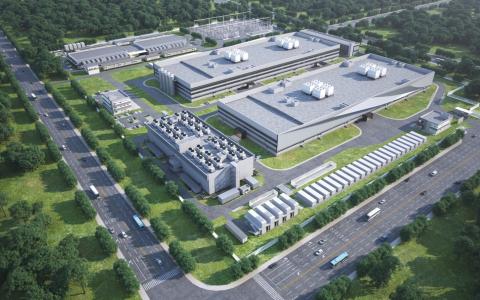As Demand Grows for Computing Power, so does the Need for Full-Stack Data Center Solutions
The digital landscape has been growing at an ever-faster rate for decades. With the continued reliance on cloud services, the widespread implementation of 5G cellular networks, and more recently the astronomical takeoff of AI and ChatGPT, this trend only looks set to increase in the coming years.
Matching this increased demand is a tall order for the data center industry. This additional computing power requires more energy, more space, increased cooling and faster delivery. All this while doing so in a sustainable and eco-friendly manner. Environmental concerns and targets are no longer just a preference, but in many cases a legal or business requirement.
There are many innovative companies in the industry trying to solve these individual issues, but as with many areas of life, often the best way to address such a complex problem is through one, collective, synergistic effort. Chindata Group, a leading carrier-neutral hyperscale data center solution provider in Asia-Pacific emerging markets, is now providing exactly this type of full-stack solution, aiming to efficiently transform electric power into cutting-edge computing power.
Meeting demands with faster delivery
With demand for processing power growing exponentially, data center operators are expected to meet this demand from their customers at a faster rate than ever before. This means quicker construction while still minimizing carbon emissions and building in a green manner.
Chindata, with its subsidiary company Bridge Data Centres in Southeast Asia, addresses this by offering a containerized, prefabricated construction approach. Through the use of building, power, cooling and IT modules, designed and developed in-house but shipped and deployed to the location, the company is able to reduce on-site construction time and carbon emissions.
Chindata refers to this method as its “China factory prefabrication + parallel overseas construction model”, and the real world results are impressive. At a project in Malaysia, for example, which has an 11-month delivery timeline, the construction period took only six months, while the on-site assembly took 30 days. From assembly to delivery it took just three months to project completion, setting a new industry benchmark.
More power requires better cooling
All the extra computing power requires additional, as well as more efficient, cooling systems to match. Again Chindata achieves this through a number of innovative solutions. In a project in Lingqiu, China, for example, the company partially implemented a prefabricated plate-based liquid cooling technology, allowing for an annual power usage effectiveness (PUE) lower than1.2.
Chindata’s “X-Cooling Maglev Two-phase Cooling System” meanwhile, uses a myriad of technologies to address the cooling challenges of high-density racks. Amongst these, as the name suggests, is magnetic levitation technology, as well as evaporative condensation, phase-change heat transfer technology, refrigerant pump and AI intelligent group control.
The company developed “Kunpeng IDC Operations Management Platform”, which offers an all-in-one platform for data center operations, management, monitoring, and control with the goal of promoting the implementation of a standardized operation and maintenance system. This operation system also played a key role to keep their data centers running at the highest energy efficiency level.
Integration to improve efficiency
Of course cooling is not the only energy consumer in a data center. Increased AI use and model training is bringing with it the need for more powerful CPUs and GPUs. These chips inevitably require more electricity and a need for higher density racks, with both power supply and stability paramount.
Chindata integrates the equipment of the power supply link, in its “X-PrePower 3.0” solution, simplifying power pathways to improve both efficiency and floor space requirements; the solution can reach an overall efficiency of 98.5%, and compared to traditional power distribution modes, saves 20% or more on floor space.
Improved energy efficiency translates to a higher environmental standard, as well as reduced operational and maintenance costs. The smaller footprint meanwhile, amongst other things, helps cut down on-site delivery time from one month to just two weeks.
Improve digital connectivity
Bridge Data Centres, the subsidiary of Chindata in Southeast Asia, is the first company to build and operate hyperscale data center in Johor. The company connected the subsea cable landing point close to Singapore and established its link with the subsea cable in Cyberjaya and Bukit Jalil. This comprehensive connectivity empowered inner-country and international network accessibility, enabling seamless data exchange and global connectivity.

To optimize connectivity and enable seamless data exchange between the data centers in Malaysia and the receiver in Singapore, the company established a dedicated zone that facilitates efficient interconnection. This zone serves as a robust platform that empowers their clients to establish secure and high-speed connections, ensuring the smooth and reliable transmission of data.
By establishing a state-of-the-art data center in the area, the company contributed to the growth of the local technology ecosystem by generating opportunities for investment in innovative high-tech industries, and bringing employment opportunities for the local workforce which will also stimulate economic growth in the area.
The presence of Bridge Data Centres in Johor not only supported the regional technology development but also brought substantial social benefits to the local community.
The full stack solution gains recognition
With all these developments, it is only natural the industry has begun to recognize our achievements. At this year’s W.Media Cloud & Datacenter Awards, Bridge Data Centres won Bridging the Digital Divide award in Planet category and Data Centre Design & Build award in Project category.
With demand for data center capacity growing at an exponential rate, and with climate concerns at the forefront of the industry’s mind, solutions like those offered by BDC will be the only way to solve these juxtaposed positions.
